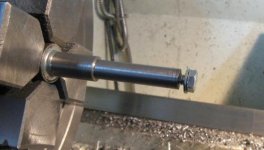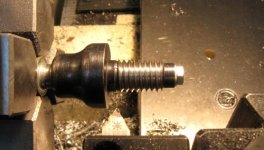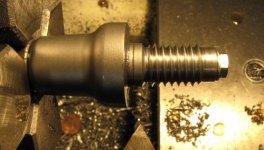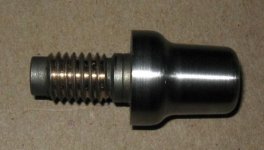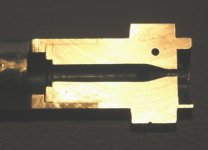I got this idea (tape on shroud threads) when casting about for a readily accessible method to tighten the fit of the shroud on an old 722 action. The best way to evaluate the fit is to disassemble the striker assembly and then screw the shroud (no firing pin, spring or cocking piece) into the bolt, and then back it out to the same position as when the bolt is cocked. Mine was very loose, and I don't have a lathe. I wrapped the part of the threads between the end of the cocking piece notch, and where the threads end at the front of the shroud with several wraps of the thin white teflon tape, stretching the tape so that it formed into the threads. There was some resistance as I put the striker assembly into the bolt. After reassembling the bolt, the thing that I noticed was that the sound of dry firing was greatly reduced. It was my thought that reducing the vibration produced before the bullet exits might be a good thing. The other shroud mod I got from Jim Borden. It was to limit the shroud's rotation while the bolt is being opened and closed. This can be done by more than one method. A friend did his by epoxying shim stock to the flats on the bottom of the shroud to minimize the clearance between them and the bottoms of the lug raceways. This keeps the cocking piece in better alignment, closer to vertical, reducing the chance of its rubbing the trigger side plate and improving the consistency and correctness of its contact with the trigger's top lever. In any case, I think that all of the efforts toward improving shroud fit that have been reported in this thread and in the one that Lynn deleted are interesting. As to results, a friend, who did the tape and shims told me that his 6BR seemed to be more consistent after the modifications. His rifle is based on a sleeved 700, and gives a good account of itself. He is not one to try everything that comes along, or to see results where they don't really exist. I know that the tape has to be replaced every so often, but since I do have a Kleindorst tool for removing striker assemblies, this is no big deal. Lynn's report of improving accuracy by replacing striker springs interests me. I would like to hear from others on this. Also, the idea of shimming springs is of some interest. Remingtons use the fit at the front shoulder of the firing pin to guide the firing pin and if the fit is too loose with the bolt body the pin has to slide on the tapered section farther forward to "find" the hole in the bolt face. This may cause a vibration that is counterproductive. Designers of custom actions and some of those who bush firing pin holes have made the bore for the tip and the length of the parallel part of the tip long enough so that the tip doesn't back out of the corresponding part of the hole as the rifle is cocked, to address this situation. Maybe a shim could be fitted to the front of the spring that would improve the centering of the pin, and reduce another source of inconsistent vibration.


